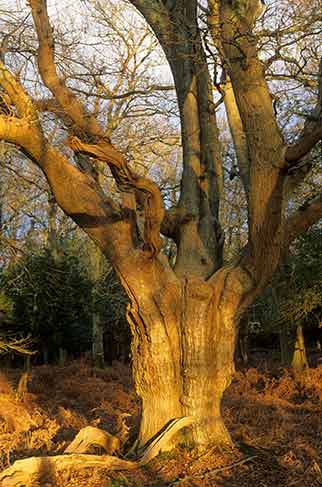Pollards and Coppiced trees

in Matley Wood
Trees with multiple trunks sprouting from just above head height are called pollards – they have been pollarded, or shrouded as it is also called, often more than once.
Pollarding involves cutting a tree to encourage the growth of new shoots, allowing repeated harvests of timber to be taken. The cuts were made above the reach of commoners’ stock, and deer, which removed the need for protective wood-banks and fencing.
Beech and oak were often cut in this way, and so were hollies. Cut holly branches were often strewn on the ground, and used as browse for the stock, and deer, whilst some were sent to market for the Christmas trade.
But although pollarding often significantly increases the trees' lifespan, the stems of pollards are not as stout as those left uncut, and were less suitable for use in the shipbuilding industry. Consequently, following concerns about the rapid depletion of timber stocks for the Navy, in 1698 the ‘Act for the Increase and Preservation of Timber in the New Forest’ reached the Statute Book. Amongst other things, this forbade the pollarding of beech and oak, and, although a little illegal cutting continued, such trees can be considered with a degree of certainty to predate the Act.
In recent years, pollarding of hollies has resumed so as to remove old wood and prompt re-generation of new. In the short term, this lets increasing light reach the woodland floor, and increases overall woodland diversity.
Notice, too, that some trees have multiple stems growing from ground level – this is particularly so with New Forest hollies and hazels. When trees are cut in this way they are said to have been ‘coppiced’. Coppiced trees, like pollards, respond by sending out multiple shoots to replace the cut timber, but of course, unless they are behind fences, there is no protection from commoners’ stock, and deer.
References:
A Wild Heritage, The History and Nature of the New Forest: Terry Heathcote
More links
Other related links
Search this site

Sadly, 58 animals were killed - 35 ponies, 13 cows, 8 donkeys and 2 sheep, whilst a further 32 were injured - 3 pigs, 9 donkeys, 11 cows and 9 ponies.
(Forty-three accidents occurred in daylight, 15 at twilight and 101 in the dark. Twenty-seven accidents were not reported by the driver involved).
Here's just one horrific example - Three donkeys killed in collision with van at notorious New Forest blackspot (Advertiser and Times)

